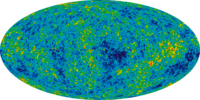
Photo from wikipedia
In the local Universe, the existence of very young galaxies (VYGs), having formed at least half their stellar mass in the last 1 Gyr, is debated. We predict the present-day… Click to show full abstract
In the local Universe, the existence of very young galaxies (VYGs), having formed at least half their stellar mass in the last 1 Gyr, is debated. We predict the present-day fraction of VYGs among central galaxies as a function of galaxy stellar mass. For this, we apply to high mass resolution Monte-Carlo halo merger trees (MCHMTs) three (one) analytical models of galaxy formation, where the ratio of stellar to halo mass (mass growth rate) is a function of halo mass and redshift. Galaxy merging is delayed until orbital decay by dynamical friction. With starbursts associated with halo mergers, our models predict typically one percent of VYGs up to galaxy masses of $10^{10}$ M$_\odot$, falling rapidly at higher masses, and VYGs are usually associated with recent major mergers of their haloes. Without these starbursts, two of the models have VYG fractions reduced by 1 or 2 dex at low or intermediate stellar masses, and VYGs are rarely associated with major halo mergers. In comparison, the state-of-the-art semi-analytical model (SAM) of Henriques et al. produces only 0.01% of VYGs at intermediate masses. Finally, the Menci et al. SAM run on MCMHTs with Warm Dark Matter cosmology generates 10 times more VYGs at masses below $10^8$ M$_\odot$ than when run with Cold Dark Matter. The wide range in these VYG fractions illustrates the usefulness of VYGs to constrain both galaxy formation and cosmological models.
Journal Title: Monthly Notices of the Royal Astronomical Society
Year Published: 2018
Link to full text (if available)
Share on Social Media: Sign Up to like & get
recommendations!